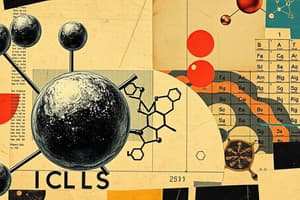Podcast
Questions and Answers
What is the smallest unit of matter that retains its identity?
What is the smallest unit of matter that retains its identity?
- Protons
- Electrons
- Atoms (correct)
- Neutrons
Which part of an atom carries a positive charge?
Which part of an atom carries a positive charge?
- Nucleus
- Neutrons
- Protons (correct)
- Electrons
What is the term for the specific number of protons in an atom's nucleus?
What is the term for the specific number of protons in an atom's nucleus?
- Neutron count
- Atomic number (correct)
- Electron mass
- Energy level
In which part of an atom do electrons orbit?
In which part of an atom do electrons orbit?
What is the role of neutrons in an atom?
What is the role of neutrons in an atom?
What determines an atom's chemical identity?
What determines an atom's chemical identity?
What is the main purpose of the periodic table in chemistry?
What is the main purpose of the periodic table in chemistry?
Which type of bond involves the sharing or transfer of electrons between atoms?
Which type of bond involves the sharing or transfer of electrons between atoms?
What determines if a covalent bond is strong or weak?
What determines if a covalent bond is strong or weak?
Which of the following is an example of a diatomic molecule?
Which of the following is an example of a diatomic molecule?
How does understanding atomic and molecular structures benefit materials scientists?
How does understanding atomic and molecular structures benefit materials scientists?
Why is the study of atoms and molecules considered the foundation of modern chemistry?
Why is the study of atoms and molecules considered the foundation of modern chemistry?
Study Notes
Atoms and Molecules: Unraveling the Fundamentals
Atoms and molecules are the building blocks of our world, forming the materials that make up everything around us. To delve deeper into this fascinating realm, let's first explore the atomic structure.
Atomic Structure
Atoms are the smallest units of matter that retain their identity, consisting of a dense, positively charged nucleus surrounded by a cloud of negatively charged electrons. The nucleus is made up of protons and neutrons. Protons carry a positive charge, while neutrons are neutral. Electrons orbit the nucleus, held in place by electrostatic forces.
Atoms have specific numbers of protons, neutrons, and electrons that give them their unique properties. The number of protons in an atom's nucleus, called its atomic number, determines the atom's chemical identity. For instance, hydrogen, the simplest atom, has one proton, one neutron (usually), and one electron. Oxygen has eight protons, eight neutrons (typically), and eight electrons.
Each electron is associated with a specific energy level, which is quantized. This means that electrons can only exist in discrete energy levels, not continuous ones. Electrons in lower energy levels are less likely to be displaced, while those in higher energy levels are more vulnerable to being removed or excited.
Molecules
Molecules are formed when two or more atoms bond together. The bonding process involves the sharing or transfer of electrons between atoms, leading to the formation of covalent bonds. These bonds can be strong or weak, depending on the type and strength of the electronegativity between the atoms involved.
Molecules can be classified based on their bonding patterns and the arrangement of their constituent atoms. The simplest molecular structure is the covalent bond between two atoms, forming a diatomic molecule such as hydrogen (H₂) or oxygen (O₂). As the number of atoms in a molecule increases, so do the possible bonding patterns and molecular geometries, leading to a rich variety of molecular structures.
The Periodic Table
The periodic table, a table of the chemical elements arranged in order of increasing atomic number, plays a crucial role in understanding the relationships between elements and their chemical properties. The periodic table can be grouped into periods, rows of elements, and groups, columns of elements, with each element having a unique set of chemical properties.
The periodic table helps us understand patterns in atomic structure and behavior, making it easier to predict the properties and chemical behavior of elements in their compounds.
Applications
Atoms and molecules, and our understanding of their structure and behavior, have a wide range of applications. For example, chemists design new materials with specific properties by manipulating the atomic and molecular structures of their components. Materials scientists use this knowledge to create advanced materials with unique properties, such as high-strength metals, lightweight composites, and high-performance plastics.
Understanding atoms and molecules is also essential to our understanding of life and the universe. Biologists use this knowledge to study the structure and function of living organisms, while astronomers study the composition of stars and planets.
In summary, the study of atoms and molecules is the foundation of modern chemistry, offering a fundamental understanding of the world around us and the potential for future advancements in science and technology.
Studying That Suits You
Use AI to generate personalized quizzes and flashcards to suit your learning preferences.
Description
Explore the fundamental concepts of atoms and molecules and their roles as the building blocks of matter. Learn about atomic structure, molecular bonding, the periodic table, and the wide-ranging applications of this knowledge.




